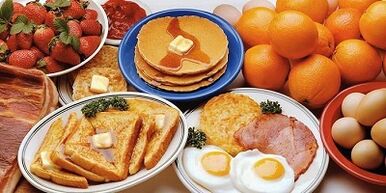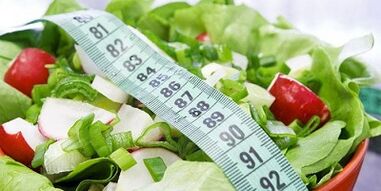Doctors, fitness instructors and nutritionists advise in all questions about safe weight loss for the body to adhere to the principles of proper diet for weight loss.They recommend the same weight gain and figure maintenance system, which helps you understand that a healthy diet is universal and that you can achieve all of your body building goals with it.However, how to adapt the general rules to a specific goal and should proper nutrition be seen as a strict diet with the prohibition of any deviation to the left?
What does proper nutrition mean for weight loss?
Losing weight without compromising your health and the stress of hunger is what a healthy diet gives you.Some people are afraid of the need to count the amount of portions and weigh food, but after a few weeks of proper nutrition, a person learns to determine by eye what and how much he can eat.This system does not imply strict adherence to grams, so a minimal error will not cause weight stagnation.
The right ratio of protein, fat and carbohydrates

Every food product consists of nutrients, and the basis consists of the 3 most important ones - proteins, fats and carbohydrates.They are abbreviated as BZHU.The ratio of these elements in the daily diet is no less important for the quality of the body than the total amount of food per day.According to nutritionists, the issue of BJU balance should be put in the foreground, because if you violate these principles, you will not achieve fat burning while losing weight.
Proper nutrition for weight loss includes the individual calculation of the amount of each nutrient and several basic principles associated with it:
- Carbohydratesis a key nutrient that supplies the body with energy, so it should occupy half of the daily plate or a little more.When calculated individually, the daily amount of protein is 4 g for every kilogram of your weight.
- Fats- is also a very useful element, which is mainly a source of vitamins and acids needed by the nervous system and the heart.For the normal functioning of the body, consumption of 1.1 g of fat per kilogram of existing weight is required.
- Squirrels- the "building blocks" of your muscles.Some open sources advise focusing on them when losing weight, but the principles of proper nutrition for weight loss without harming the body refute this recommendation.A person who has no sports training should not eat more than 1 g (per 1 kg of net weight).
Daily calorie intake
The amount of food that a person can and should eat during the day is determined by his basal metabolism.This indicator is calculated individually, taking into account the following indicators:
- gender;
- weight;
- growth;
- year.
However, the number obtained is not final if you decide to start losing or gaining weight.It also does not take into account physical activity - even walking from home to work, that is, it includes the number of calories needed for the life of a bedridden person.According to the principles of proper nutrition, it is necessary to additionally multiply this indicator by the level of activity, and then, if weight loss is planned, reduce the existing number by 10-20%.
Principles of proper nutrition for weight loss
In addition to the above caloric and dietary nutritional standards, a healthy diet is based on a few more rules that you must know and follow:
- Avoid fasting.
- Do not skip main meals.
- Breakfast and lunch are more filling than dinner.
- Give preference to fresh vegetables, not thermally processed.
- Try not to use salt when cooking.
Weight loss products

Sweets are a must, and buckwheat with green salad is your best friend: this is how women imagine the daily diet of a person who adheres to the principles of a healthy diet.However, a healthy menu is much more diverse, and the recipes for healthy dishes may even look no worse than "harmful" ones and can be compared to restaurant ones in appearance.
The number of permitted foods is significantly greater than the list of prohibitions, and after changing your eating habits (mostly formed within 3 weeks), you will no longer feel deprived.
What can you eat to lose weight
The list of products that do not interfere with the reduction of fat reserves is just long enough to make the right menu for yourself in a month, almost without repetition.Mostly ideas about dishes are limited by the assortment in stores or the skills of the hostess.
Experts call absolutely dietary products:
- Cereals are a source of slow carbohydrates and B vitamins. Particularly recommended: oatmeal, buckwheat, millet, pearl barley.
- Legumes are light plant proteins.Chickpeas, lentils and beans are ideal for weight loss, but it is better not to rely on peas.
- Eggs - up to 2 per day, if they are with yolk, and up to 4, if they are only white.
- Vegetables contain fiber, i.e. dietary fiber.Even potatoes are allowed, but the amount of their consumption is reduced.
- Fruits and dried fruits are an excellent substitute for factory-made sweets.
- Milk - minimal to prevent calcium deficiency, lactose free.
- Fermented milk products - with caution, in the evening yogurts will be only natural.
- Fresh cheese is preferably low-fat, but it is not necessary to look for low-fat.
- The cheese is mostly hard.
- Honey, nuts.
- Vegetable oil - preferably olive oil, up to 30 ml per day.
What to avoid when losing weight
The main enemies of the figure and factors that hinder weight loss are saturated fats and fast carbohydrates.

It's ideal to eliminate them completely from your diet while losing weight, but proper nutrition is not a diet of lettuce leaves and chicken breasts.
You are not prohibited from enjoying ice cream (simple carbohydrates, milk sugar), chocolate (simple carbohydrates) or even French fries (saturated fat), but you should:
- meet the daily need for calories;
- introduce into the menu rarely and not before bedtime.
A proper diet for weight loss implies an emphasis on healthy food, so it is advisable to eliminate as much as possible from the diet:
- sausages and their "relatives" - bacon, bacon and so on;
- sugar (pay attention to product ingredients);
- mayonnaise;
- sweet;
- baking.
Diet plan for weight loss
In addition to the allowed and forbidden foods, there are several points that you should also think about when planning your daily diet:
- type of heat treatment;
- portion size;
- meal frequency;
- drinking regime.
How to prepare healthy meals
The number of recipes for healthy dishes is slightly less than the standard ones, so you don't have to worry about the lack of culinary ideas.All methods of thermal processing are available to you, including frying, but it is done without oil, in a special non-stick pan.you can:
- to cook;
- bake;
- cook in a steam boiler;
- goulash;
- cook on the grill.
How many times a day to eat
Constantly feeling hungry is not something that promotes a proper weight loss diet, even if you need to lose weight urgently.If you follow the above principles of BJU balance, you will not starve, because carbohydrates will provide the desired degree of satiety.However, in addition, it is important to strictly adhere to the diet, which will help you get rid of every minute desire to chew.

According to nutritionists, the correct diet is to eat up to 6 times a day.However, this figure is determined individually:
- If you eat a portion of meat, saturation can last up to 4 hours, and the product will also take a long time to digest.
- If you snack on vegetables, after 2 hours the body should be given a new "dose" of food.
- According to the rules of a healthy diet, it is advisable not to take long (longer than 4 hours) breaks in the menu, in order to avoid a sugar drop, which will lead to insulin spikes and a slowdown in metabolism.
Portion size for a proper diet for weight loss
Do you eat until you finish or feel hungry after eating?A question that bothers most women who take out the scale before cooking.For some, losing weight inexorably means reducing portions to ridiculous sizes, which causes breakdowns, because satiety does not occur.Doctors do not agree with this policy - even for weight loss, proper nutrition does not require fasting: the amount of food on the plate should be such that after half an hour you do not feel empty in the stomach, but also do not suffer from overeating.
Follow these guidelines:
- The amount of chicken or fish meat per portion is 100-150 g, visually it should not exceed the size of your palm.
- The amount of cereal and pasta is a handful, or 50 g or a little more.
- You have to eat a lot of vegetables, so their part is shasha palms (food is cut into pieces).
- It is recommended to match the correct portion size with the daily calorie content: do not exceed 400 kcal for the main meal and 200 kcal for the snack.
Compliance with the drinking regime
Some women and men underestimate the importance of water in their diet, especially when losing weight.Some people confuse the terms "beverage" with "tea" or "coffee", but the drinking regime is pure, non-carbonated water, which does not actively burn fat, but is necessary for weight loss.Failure to follow a proper drinking regime leads to lymph stagnation, blood thickening, dehydration, swelling, poor skin tone and deterioration of well-being.

Key recommendations on what and how to drink for proper weight loss:
- A glass of water before a meal is a mandatory element of your menu.
- Each cup of coffee must be replaced with 0.6 liters of pure water, because... This drink causes dehydration.
- Juices, compotes and other drinks are food;they do not count towards the regime.
- Forget about the 2 liter rule: the optimal amount of water is calculated individually.The norm for humans is 30 mg/kg.
Proper balanced diet for weight loss - menu
In order to understand how to compose a daily diet, a menu for weight loss that does not cause hunger is proposed below.This scheme can be expanded by adding 1-2 more snacks with vegetables/fruits, cheese, nuts.
Approximate daily nutrition program:
- Breakfast.Oatmeal or other porridge with water.A handful of almonds, a spoonful of honey.
- A snack.Whole grain bread, hard cheese (up to 40 g), lots of greens.
- Dinner.Chicken soup with vegetables, a piece of boiled chicken meat.
- Afternoon snack.Salad of canned red beans, peppers and cucumbers.
- Dinner.Baked flounder with asparagus and orange.























